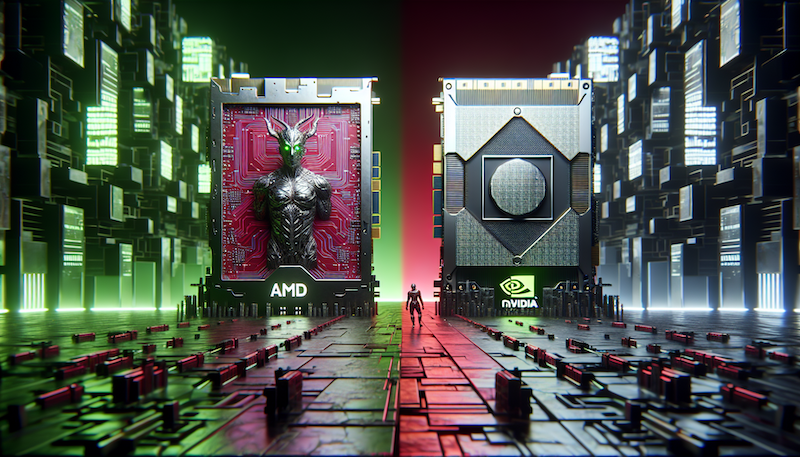AMD vs Nvidia: The AI GPU War You Didn't Know About
This comes as no surprise, considering the AI software sector's reliance on powerful GPUs to process complex computations at unprecedented speeds. The battle for dominance in this segment is not just about bragging rights; it's about leading a market expected to balloon to USD 400 billion by 2027 from its former $40 billion just last year, showcasing the immense growth and potential of AI GPU technology [1] [2].
As the AI software market continues to expand, so does the need for advanced AI GPUs, positioning both Nvidia and AMD at the forefront of technological innovation to meet this demand. Nvidia has long been the titan in this arena, but AMD is making strategic moves to challenge this dominance. This contest is not only about the companies themselves but also about driving the future of AI, with the market projected to hit about $100 billion this year alone. The ongoing AI GPU war between AMD and Nvidia underscores the significant stakes involved, as each strives to outpace the other in performance, innovation, and market footprint [1] [2].
The Surge in AI Compute Demand
The surge in AI compute demand is a multifaceted phenomenon, driven by the expanding capabilities and applications of AI across various sectors. Here's a closer look at the key factors fueling this demand:
- Exponential Market Growth: Predictions indicate a 60% annual increase in sales of AI-focused GPUs and chips from 2022 to 2027, with the AI GPU market expected to reach a staggering USD 400 billion by 2027 [3][1][2]. This growth is not confined to a single sector but spans across data centers, cloud computing, and B2B and B2C applications, underscoring the universal appeal and application of AI technologies.
- Generative AI Applications: The rise of generative AI applications such as ChatGPT and Sora has significantly increased the need for computational power. This demand is further segmented into approximately 70% from B2C applications and 30% from B2B applications, covering a wide array of use cases from content creation to customer engagement [8]. These applications are compute-bound, meaning more compute directly translates to better product quality, making access to affordable compute resources a critical success factor for AI companies [9].
- Computational and Energy Constraints: The computational cost associated with AI models is substantial, with a single forward pass for a model requiring approximately 2np floating point operations (FLOPs) and training taking about 6*p FLOPs per token [9]. This demand for compute is so high that it outstrips supply by a factor of 10, leading to a highly concentrated market for AI hardware, including chip design, fabrication, and data centers [7][9]. Moreover, the increasing reliance on AI computing raises concerns about energy consumption and the strain on resources, with data centers consuming significant power and contributing to carbon emissions [10].
This detailed look into the surge in AI compute demand showcases the critical role of GPUs in powering AI advancements, highlighting the competitive landscape between AMD and Nvidia in meeting this burgeoning demand.
Nvidia's Dominance in the Market
Nvidia's dominance in the AI GPU market is underpinned by several key factors that highlight its comprehensive approach to AI computing and its substantial market share.
- Innovative Technologies and Market Share:
-
- Nvidia's CUDA architecture, optimized for parallel processing, supports scientific research, AI, and deep learning, reinforcing its market position [11].
- The introduction of cutting-edge technologies such as ray tracing, DLSS, and AI hardware with RTX series GPUs has set industry standards [11].
- Nvidia controls a significant portion of the AI chips market, with expectations to dominate 85% of it this year [3], and currently holds over 90% share due to its full-stack AI computing solutions [2].
- Next-Generation Chips and Financial Growth:
-
- Development of next-gen chips like the H100 and the upcoming H200, featuring 141GB of HBM3e, promises to double the inferencing performance, showcasing Nvidia's commitment to innovation [12] [13].
- Financially, Nvidia has shown stellar growth, with its stock gaining 82.5% in the fiscal first quarter of 2024, indicating healthy gains for investors [2] [5].
- Comprehensive Solutions and Developer Engagement:
-
- Nvidia offers a one-stop solution for AI chipmaking, combining hardware, networking kit, and software, making it challenging for competitors to displace its dominance [15].
- The company's engagement with over 4.7 million developers worldwide using its CUDA and other software tools demonstrates its significant influence in the AI GPU space [5].
Nvidia's strategic emphasis on both hardware innovation and software ecosystem development has solidified its leadership in the AI GPU war, positioning it as a pivotal player driving the future of AI technology.
AMD's Strategic Moves
In an ambitious stride to challenge Nvidia's stronghold in the AI GPU realm, AMD has orchestrated strategic moves, underpinning its competitive edge with groundbreaking technological advancements and strategic market positioning:
- Technological Innovations:
-
- AMD's Graphics Core Next (GCN) architecture and RDNA architecture focus on parallelism and power efficiency, enhancing gaming and AI applications' performance [11].
- The introduction of the MI300 AI chip and its advanced MI300X variant showcases AMD's leap in AI processor technology. The MI300X, with its superior FP16 AI inference performance, outpaces Nvidia's H100 by 30%, even utilizing Nvidia's software stack [12][13].
- A significant memory advantage is evident in the MI300X, boasting 192GB of high-bandwidth memory (HBM), over twice the capacity of Nvidia's H100, facilitating faster data processing for complex AI models [13].
- Market Strategy and Performance:
-
- AMD's focus on raw computational horsepower over a full-stack solution distinguishes its market approach, aiming to offer value and performance [2].
- Despite a conservative AI-related revenue forecast of $2 billion in 2024, AMD's strategic partnerships and the launch of Instinct MI300X chips for large language model training signal a strong market presence and potential growth [3][18].
- The company has secured significant endorsements from tech giants like Meta, OpenAI, Microsoft, and Oracle, favoring AMD's Instinct MI300X for its cost-effectiveness and performance, potentially reshaping enterprise preferences in the AI GPU landscape [1].
This strategic blueprint positions AMD as a formidable contender, ready to disrupt Nvidia's dominance and carve a significant niche in the burgeoning AI GPU market.
Comparative Analysis: Performance and Innovation
In the arena of AI GPUs, AMD and Nvidia present distinct paths towards innovation and performance, each with its unique strengths and market strategies.
- Focus and Strategy:
- Performance Evaluation Tools:
-
- Benchmarking software such as 3DMark and FurMark are pivotal in objectively assessing the speed and efficiency of GPUs from both manufacturers [11].
- For real-world gaming experiences, tools like FRAPS and built-in frame rate counters offer insights into how smoothly a GPU can run games, a crucial aspect for both gamers and developers [11].
- Market Impact and Innovation:
-
- While AMD is making strides in the AI business, it is still in the process of catching up to Nvidia's established dominance [2].
- The presence of AMD as a strong competitor is welcomed by AI chip customers, including cloud service providers and enterprises, as it fosters a competitive environment that benefits innovation and helps keep prices in check [2].
This comparative analysis underscores the nuanced battle between AMD and Nvidia, highlighting their respective strategies towards advancing AI GPU technology.
Market and Financial Implications
In the dynamic landscape of the AI GPU market, AMD and Nvidia are not the only contenders vying for dominance. The competition is further intensified by:
- Emerging Competitors and Technologies:
-
- Intel: With its Gaudi AI processors, Intel is expanding its footprint in the AI hardware space, aiming to leverage its existing semiconductor expertise [2].
- Custom ASICs: Companies like Broadcom and Marvell Technology are developing custom Application-Specific Integrated Circuits (ASICs) tailored for AI computations, indicating a trend towards specialized solutions [2].
- Innovative Startups:
-
- Cerebras: Known for its wafer-scale engine, which is touted as the largest processor ever built specifically for AI workloads [2].
- SambaNova Systems: Focuses on building integrated systems that optimize both hardware and software for machine learning applications, showcasing the potential for disruptive innovation in this sector [2].
The ongoing rivalry between AMD and Nvidia, with AMD traditionally playing catch-up in various markets, is a testament to the competitive nature of the AI chips market. However, the presence of other players and startups signals a broader and more diverse ecosystem, which could lead to greater innovation and possibly alter market dynamics in the long run [2].
Conclusion
Throughout this exploration of the AI GPU market, we've delved into the intense competition between AMD and Nvidia, each leveraging their strengths in a bid to lead the rapidly growing sector. The relentless advancements in AI technology have not only propelled these companies to innovate but also spotlighted the critical role of GPUs in powering future AI developments. As Nvidia continues to dominate with its comprehensive solutions and AMD aggressively challenges with strategic technological advancements, the landscape is ripe with potential for further disruption and innovation, especially as new players enter the fray.
The implications of this competition extend far beyond corporate rivalry, symbolizing a pivotal moment in technological advancement and its application across various sectors. As we watch this dynamic battle unfold, it's clear that the outcomes will significantly influence the evolution of AI applications and the broader tech ecosystem. For those intrigued by the future of AI and the evolving GPU wars,watch Tensorwave for updates, ensuring you stay informed on the latest developments and breakthroughs in this exciting and transformative domain.
FAQs
Which is more suitable for AI applications, AMD or Nvidia?
Nvidia is the leading brand in the GPU market for AI applications, thanks to its extensive experience and focus on creating graphics processing units that cater to the high computational demands of AI workloads. AMD, while not the frontrunner, has shown itself to be a competent contender, quickly adapting and following Nvidia's lead in this sector.
What has prevented AMD GPUs from being widely adopted for AI?
Historically, the only option for utilizing AMD GPUs for machine learning tasks involved investing significantly more money in AMD's server-grade cards. These cards were not only more expensive than Nvidia's consumer-grade options but also offered inferior performance, were more challenging to utilize, and lacked long-term support from AMD, making them a less attractive choice for AI applications.
Is AMD making moves into the AI industry?
Yes, AMD is actively entering the AI space, distinguishing itself as the sole technology provider capable of offering a full range of products designed to support AI deployment across various platforms, from cloud-based applications to edge computing and endpoint devices. This comprehensive product suite positions AMD as a significant player in the AI technology landscape.
What makes Nvidia's GPUs highly effective for AI?
Nvidia's dominance in the AI field can be attributed to its strategic focus on both hardware and software. By aggressively promoting its CUDA programming interface, which is specifically designed to work seamlessly with its GPU hardware, Nvidia has created an ecosystem that is highly attractive to developers embarking on AI projects. This dual focus ensures that Nvidia GPUs are considered essential tools for anyone looking to delve into AI development.
References
[1] - https://www.trendforce.com/news/2023/12/18/news-nvidia-vs-amd-the-expensive-duel-as-two-major-buyers-opt-for-amds-latest-ai-gpu/
[2] - https://www.investors.com/news/technology/ai-chips-amd-stock-vs-nvidia-stock/
[3] - https://www.fool.com/investing/2024/01/19/better-artificial-intelligence-ai-stock-nvidia-vs/
[4] - https://www.cnbc.com/2024/01/18/mark-zuckerberg-indicates-meta-is-spending-billions-on-nvidia-ai-chips.html
[5] - https://www.nasdaq.com/articles/4.7-million-reasons-why-nvidias-artificial-intelligence-ai-chip-dominance-will-be-nearly
[6] - https://www.economist.com/the-economist-explains/2024/02/27/why-do-nvidias-chips-dominate-the-ai-market
[7] - https://ainowinstitute.org/publication/policy/compute-and-ai
[8] - https://www.mckinsey.com/industries/semiconductors/our-insights/generative-ai-the-next-s-curve-for-the-semiconductor-industry
[9] - https://a16z.com/navigating-the-high-cost-of-ai-compute/
[10] - https://penntoday.upenn.edu/news/hidden-costs-ai-impending-energy-and-resource-strain
[11] - https://exittechnologies.com/blog/gpu/amd-vs-nvidia-gpu-showdown-unveiling-the-battle-of-graphics-giants/
[12] - https://www.quora.com/How-will-AMDs-new-AI-chips-compete-with-Nvidias-flagship-AI-processors
[13] - https://www.theregister.com/2023/12/21/nvidia_amd_benchmarks/
[14] - https://www.investing.com/analysis/amd-vs-nvidia-in-2024-which-ai-stock-makes-more-sense-for-your-portfolio-200645798
[15] - https://www.neogaf.com/threads/why-do-nvidia%E2%80%99s-chips-dominate-the-ai-market-the-economist.1667833/
[16] - https://www.quora.com/Why-is-NVIDIA-the-dominant-AI-chip-maker-even-though-many-companies-ARM-Apple-Qualcomm-etc-can-design-GPU-on-their-own
[17] - https://techhq.com/2023/08/how-is-nvidia-leading-ai-boom-with-chips/
[18] - https://www.cnbc.com/2024/02/02/amd-bets-on-ai-powered-pcs-as-artificial-intelligence-race-with-nvidia-and-intel-heats-up.html
[19] - https://www.forbes.com/sites/greatspeculations/2023/12/08/amd-takes-the-fight-to-nvidia-with-latest-ai-chip-launch-is-the-stock-a-buy-at-116/
[20] - https://www.amd.com/en/solutions/ai.html
[21] - https://www.datacenterknowledge.com/artificial-intelligence/amd-takes-nvidia-new-gpu-ai
[22] - https://www.hpcwire.com/2024/02/06/nvidias-dominance-in-ai-chips-challenged-by-big-tech-companies/


